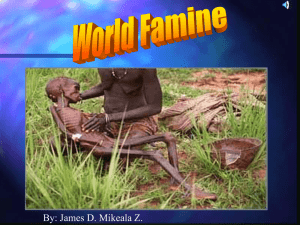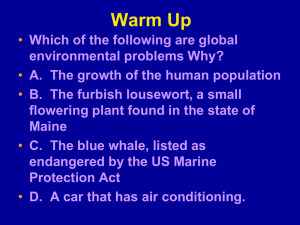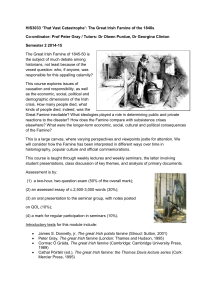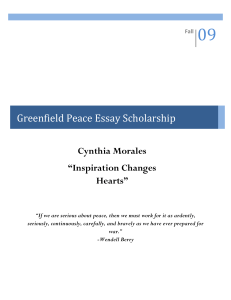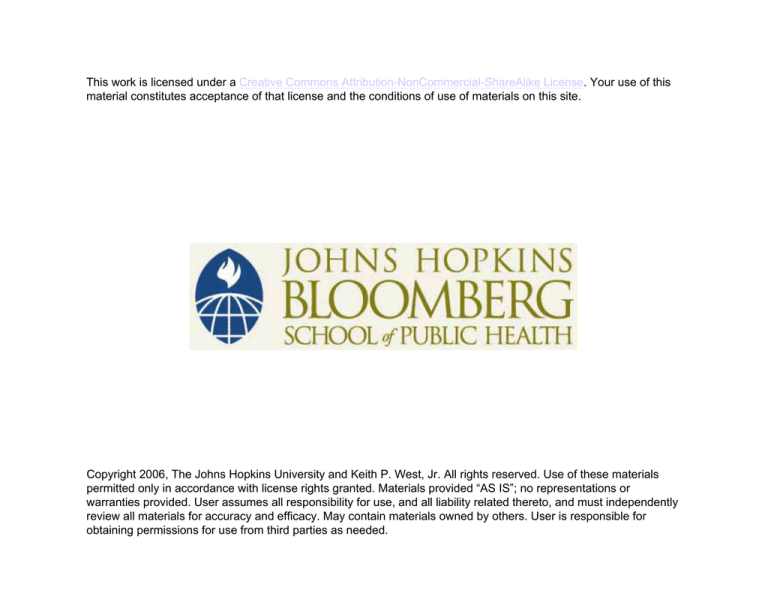
This work is licensed under a Creative Commons Attribution-NonCommercial-ShareAlike License. Your use of this
material constitutes acceptance of that license and the conditions of use of materials on this site.
Copyright 2006, The Johns Hopkins University and Keith P. West, Jr. All rights reserved. Use of these materials
permitted only in accordance with license rights granted. Materials provided “AS IS”; no representations or
warranties provided. User assumes all responsibility for use, and all liability related thereto, and must independently
review all materials for accuracy and efficacy. May contain materials owned by others. User is responsible for
obtaining permissions for use from third parties as needed.
International Nutrition
FAMINE
Keith P. West, Jr. DrPH, MPH
Photo: Keith West
There are so many
hungry people that God
cannot appear to them
except in the form of
bread.
- Gandhi
Pathophysiology of Starvation
•
•
•
•
•
Muscle wasting
Appetite diminishes
Growth slows/stops
Weight lost
Behavior changes: listless,
apathetic, confused
Photo: Keith West
Definitions of Famine
(Food supply based: inadequate)
• Widespread food shortage leading
to significant rise in regional death
rates (Blix et al, 1971)
• Sudden, sharp reduction in food
supply resulting in widespread
hunger (Brown & Eckholm, 1974)
• A community syndrome (Curry,
1978)
Definitions of Famine
(Food consumption-based)
Sudden collapse in level of food
consumption of large numbers of
people (Scrimshaw, 1987)
Lack of food over large geographical
areas sufficiently long and severe to
cause widespread disease and death
from starvation (Chamber’s
Encyclopedia)
Famine Definition
(Mortality based)
• Unusually high mortality with
unusually severe threat to
food intake of some
segments of a population
M. Ravillion, 1997
Famine Definition
(Food consumption based)
• A set of conditions that occurs
when large numbers of people in
a region cannot obtain sufficient
food, resulting in widespread,
acute malnutrition
Fred Cuny=, 1999
By the year 2000…eliminate
• Famine and related deaths
• Starvation
• Man-made disaster-induced
deficiencies
• Iodine deficiency
• Vitamin A deficiency
- ICN, Rome, 1992
Early Biblical Famine Accounts
Genesis 12:10
Famine grievous
in the land
Genesis 41:15-57 Joseph interprets
Pharoah’s dream/
predicts famine
Genesis 47:4-26
Joseph manages
famine
Biblical Famine: Forerunner of Modern Concepts
• 7 fat and 7 lean kine
• Lean kine ate fat kine
• Officers appointed to
collect 1/5th of crops in
years of plenty
• Joseph SOLD stores to
Eygptians
• Israelites sojourned from
Canaan to Egypt
• Money failed; bread for
livestock
• Seed distributed to sow on
Pharoah's new land
• Early Warning System: 7 yr
of plenty & 7 yr of famine
• Food stock depletion
• Famine commission; taxes to
build buffer stocks
• Food aid (Title 2…or Title 1!)
• Mass migration
• Failure of monetary economy
• Bartering away live assets
• Land transfers, indenturing
Famines have Influenced Power Struggles
throughout Human History
Famine swelled ranks of Crusades (12th C)
•Peasants stormed Bastille following spikes
in bread prices (Fr Revolution) (1789)
•Famines preceded Bolshevik Revolution
•“Great Leap” Famine preceded the Cultural
Revolution in China (1958-59)
•Ethiopian famine preceded the overthrow
of Haile Selasi (1974)
•Famine (possibly) brought N Korea regime
to fully understand potential consequences
Famine seems to be the last,
the most dreadful resource of
nature … premature death
must visit the human race.
Rev. T. Malthus, 1798
The Great Irish Famine
From 1846-48.
Attributed to failure of
potato crop due to a
fungus
~1.5 million died
~1.5 million migrated
Class famine (market
failure): Farming
peasantry most affected
Ireland: 1846-47
Potato blight
No money among peasants
No effective demand for food
No peasant markets
No food for peasantry
Plus Food exports
Laissez Faire policy
Several Major Famines in the 20th Century
China: 1959-60
Russia: 1918-21
Ukraine: 1931-34
India: 1943
Bangladesh: 1974
Ethiopia: 1974; 1984-85
Somalia: 1992-93
Sudan:1984-85; 1998
East Timor: 1978
North Korea: 1997-98
Famine in Post Czarist Russia
1918-1921
• Lenin empowers Commissariat of Food
to extract grains from peasants
• Peasant uprisings
• Communists wage class warfare
• Grain production fell to 1/2 of 1914
• Massive international relief in 1921
Stalin’s Reign of Terror
1928:
Stalin initiated collectivization
1929:
Peasant land merged into
“factory-farms”
Peasants organized into
“brigades”
Rich peasants (kulaks) killed
Grain stocks seized
Peasants rebelled, destroyed
livestock/grains
1930-33:
Massive food shortages
7 million died
Destroyed
food
production
capacity
and markets
in grain
belt (esp
the Ukraine)
Ukraine Famine: 1931-34
• Stalin used famine to crush Ukraine
Nationalism/Cossack rebellion
• Militia guarded grain stores
• Grains shipped out of Ukraine
• Ukraine covered with corpses
• Widespread reports of cannibalism
• 5 (of 7) m who died in Russia in
1933-4 from famine died in Ukraine
• Covered up for decades
Famine in China
108 BC to 1911 AD:
1828 major
famines
J. Becker, 1996
Northwest China: Famine of 1927
• 60 million affected; 3-6 million
perished
• Horrid descriptions of famished in
rural areas
But also there were…
• Rich men, grain hoarders, moneylenders, landlords with armed guards
to defend them
• Cities with plenty of grain and food
China Int’l Famine Relief Commission
Western China: Famine of 1929
• Famine started with severe drought
• Destitution caused by “millions of
armed men”, crushing exactions
from landlords, enforced taxation
and poor government
Int’l Famine Relief Commission
American Red Cross
“Great Leap” Famine in China
1959-1961
• Worst famine in human history; until
recently, least well-known
• Estimated 30 million deaths
• Followed a decade of investment in
heavy industry vs agriculture, state
monopolization, land reform,
collectivization and commune
formation, heavy rural grain
taxation, market restrictions
DL Yang, Calamity & Reform in China 1996
The Great Leap Famine: References
• Yang DL. Calamity and Reform in China: State,
rural society and Institutional Change since the
Great Leap Famine. Stanford, CA: Stanford
University Press, 1996.
• Becker J. Hungry Ghosts: Mao's Secret Famine The First Full Account of the Tragedy that Claimed
over 30 Millions Victims. New York: The Free
Press/Simon & Schuster, Inc 1996.
• Newman LF (ed). Hunger in History: Food
Shortage, Poverty and Deprivation. Oxford:
Blackwell, 1992.
Indian Famines
Vulnerable groups
• Agricultural laborers
• Rural artisans
Bengal Famine of 1943
Cause: “Shortage of rice supply
for consumption”
- Famine Inquiry Commission
Bengal Famine of 1943
Rice Supply
~5% lower than previous 5 years
13% higher than 1941
9% higher per capita than 1941
Amartya Sen, 1978
Bengal Famine of 1943
Class Famine
Rural event: ↑ prices + ↓ wages
Target groups: fisherman, transport
workers, agricultural
labor
War economy: fears of invasion fueling
stockpiling, hoarding,
trade restrictions
A. Sen, 1978
Famine in Bangladesh: 1974
• Need to know
“abnormal”
conditions from
“normal”
stresses
Courtesy of CIA World Factbook
Azmirigang Thana, Sylhet, Bangladesh:
In December: Normal Dry Season
Photo: Keith West
Azmirigang Thana, Sylhet, Bangladesh:
In August: Normal Wet Season
Photo: Keith West
Bangladesh: Pre-1974 Famine
1970
War, refugee migration
1971
Partial crop failure
1972
Continued crop failure
More refugees
1973
Partial monsoon failure
1974
Flood
Estimated Production of Rice in
Bangladesh During 1967-1974
Year
Total Domestic Production
1967-1968
110.53
1968-1969
112.57
1969-1970
119.19
1970-1971
110.79
1971-1972
98.87 (~15% decline)
1972-1973
100.20 (~15% decline)
1973-1974a
118.01 (Famine year:
a
normal food prodn)
Estimated. M. Rahman, Ecol of Food & Nutr 1978
The Daily Market: Where the Economy Acts on Peoples
Lives each Day
Photo: Keith West
POST-HARVEST
PRE-HARVEST
Producing Areas
Producing Areas
Traders
Traders
Urban
Markets
Urban
Markets
Starvation is a matter of
not having enough food
to eat, not a matter of
there being enough food
to eat.
- A.K. Sen
Entitlement – The legal means
to command food and other
commodities (to survive)
Entitlement has two components:
• Endowment
(resources to exchange; internal)
• Exchange Opportunities
(cost of living; external)
Endowment
• Labor (ability to perform work)
• Cash or credit
• Assets (to exchange for food)
Food Exchange Entitlements
Opportunities the market offers
to a person to exchange other
commodities (money, labor,
barter, etc.) for food.
- A.K. Sen
Entitlement Dynamics
Households cope with changes in
food production, prices, wages and
employment by:
•
•
•
•
•
•
•
•
•
Changing cropping patterns
Intensifying off-farm work
Remitting food aid for income
Drawing on savings
Selling assets
Borrowing money
Migrating for work
Cutting back meals
Reducing non-food spending
Coping Strategies Phases:
Buffers From Famine
• Risk Insurance – minimize risk/
manage shortfalls
• Endowment Loss – depleting
key assets to
survive this crisis
• Destitution – migrating to
survive
Entitlement Dynamics
Risk Insurance Phase
• Increase buffer stocks (good years)
• Alter cropping system
• Restructure herds for drought
resistance
• Diversify income sources
• Labor migration
Risk Insurance
(with asset depletion)
• Loans via indigenous/social
networks
• Sale of small livestock
• Sale of household assets
• Include “famine foods” in diet
• Accept lower wages
“Nyeka” root
from bed of
Shire River is
consumed in
southern Malawi
during severe
dry seasons
Photo: K West
Endowment Loss Phase
• Sale of productive HH assets
• Sale of large livestock
• Sale/mortgaging of land
• Indenturedness
• Dietary restriction
Land transactions at the Land Transfer Office,
Sundarganj, Northwestern Bangladesh
Photo: Keith West
Destitution Phase
• Distress migration: to camps,
urban centers
• Death of most vulnerable
Destitute Burmese refugees in Bangladesh, 1978
Photo: Keith West
Armed Conflict: A Cause of Famine
• Disrupts agricultural production
- Kampuchea (1979)
- Mozambique (1980s)
- Southern Sudan (1990s)
- Somalia (1990's)
• Hinders food distribution/ economic
recovery
• Exacerbates famine conditions
Somalia: Conflict → Food Insecurity
1990
1. Fighting destroyed harvests
2. Militia looted assets needed to
plant and sow
3. Bandits closed trade routes
4. Bandit attacks discouraged food
growing
5. Fighting paralyzed relief efforts
S. Hansch, et al., 1994
Somalia: Excess Deaths Due
to Complex Causes
Late 1991: Conflict-induced
mortality
Early 1992: Famine and
infectious diseases
Chronic climatic conditions can predispose regions to famine
Areas of chronic low
rainfall in Africa
Vegetation Index in Africa
Maps courtesy of NOAA, http://www.noaa.gov.
Famine (Complex Emergencies) in Africa
Preconditioned by …
• Subsistence agriculture
• Poor transport infrastructure
• Weak popular participation
• Armed conflict
• Economic disruptions
• Drought
Von Braun, IFPRI, 1991
North Korea (DPRK)
24 million population (1996) 60% urban
123 sq km, 20% arable
Centralized socialist system
Life expectancy ~74 yr
Adult literacy 100%
GNP $970 per capita (1996)
Courtesy of CIA World Factbook.
North Korea Famine: Complex Causes
Historically famine-proned region
1989
Collapse of Soviet Union
1994
Kim Il Sung dies
1995
Extensive flooding/crop damage
145/200 counties; 1.7 MMT grain lost/ 5.9 MMT grain affected
1996
Floods destroy ~12% of crops
1997
Drought/tidal waves
Acute vs Non-acute Nutritional Status
Katona-Apte & Mokdad, 1998
WHZ, mean
Cases
(110)
-2.4
Control
(108)
-0.8
RPR
Fa dead
15%
2%
7.5
Mo dead
3%
1%
8.0
Either dead
22%
3%
7.3
Hospitalized
p 3 mo
80%
12%
6.7
RPR = relative prevalence ratio
North Korean Migrant Survey
March, 1998
•
•
•
•
Yanbian Prefecture, China
1.5 sites/NGO assisted
Migrant and non-migrant HHs
HH composition, food, mortality
C. Robinson, et al., Lancet, 1999
CDR per 1000
North Korea Migrant Survey
Mortality in Households
60
40
20
0
1995
1996
1997
Robinson, et al., 1999
North Korea Famine Responses
1995
Bilateral appeals for food aid
- Japan, Egypt, S. Korea
- Cutbacks in Chinese aid
1997
WFP $95 m appeal for
200,000 MT food
1998
UNICEF/WFP/EU surveys
show moderate malnutrition
WFP/FAO/UNICEF Survey, August, 1997
n = 3965 <7 y/o children
40 kindergartens/nurseries in
18 countries (selected)
weight, height measured
110 cases acute MN/108 controls
Katona-Apte & Mokdad, 1998
“Classic” Chain of Causation
Food Shortage
Starvation
Famine
Modern Concept of Causation
Food Shortage
(?)
Initiating/
Intervening
Factors
Normal
Pre-famine
Famine
•Food availability
decline (FAD)
•Market Dynamics
•Gov’t/ Int’l
Response
•War
Concept of Disease Causation:
Similar concept can be applied to causation of famine…
Individual or component causes leading to a sufficient cause
that precipitates famine, and the responses to famine
Some Component Causes of Famine
•
•
•
•
•
Crop Failure (eg, due to weather, flood)
Market Failure (ie, ineffective demand)
Failed Central Economy
Conflict-Anarchy
Lack of free press
Population Distributions of Nutritional Status
During Times of Famine
Shifting of a population toward starvation with
increasingly severe prefamine and famine conditions
Starvation threshold
Normal
Prefamine
Famine
Population
Famine Relief
A Policy Failure
Policy Issues
• Civil conflict resolution
• Drought (flood) management
• Dry season farming and
development
• Animal husbandry
• Pest control
Policy Issues
• Tax relief
• Pastoral protection
• Early warning system
• Food support mechanisms
• Good governance/Democracy
• Freedom of speech/press
Famine prevention policies
should support indigenous
capacity to withstand (cope
with) a variety of stresses.
Copyright 2005, Keith P. West, Jr. and The Johns Hopkins University. All rights reserved. Use of these materials permitted only
in accordance with license rights granted. Materials provided “AS IS”; no representations or warranties provided. User assumes
all responsibility for use, and all liability related thereto, and must independently review all materials for accuracy and efficacy.
May contain materials owned by others. User is responsible for obtaining permissions for use from third parties as needed.



